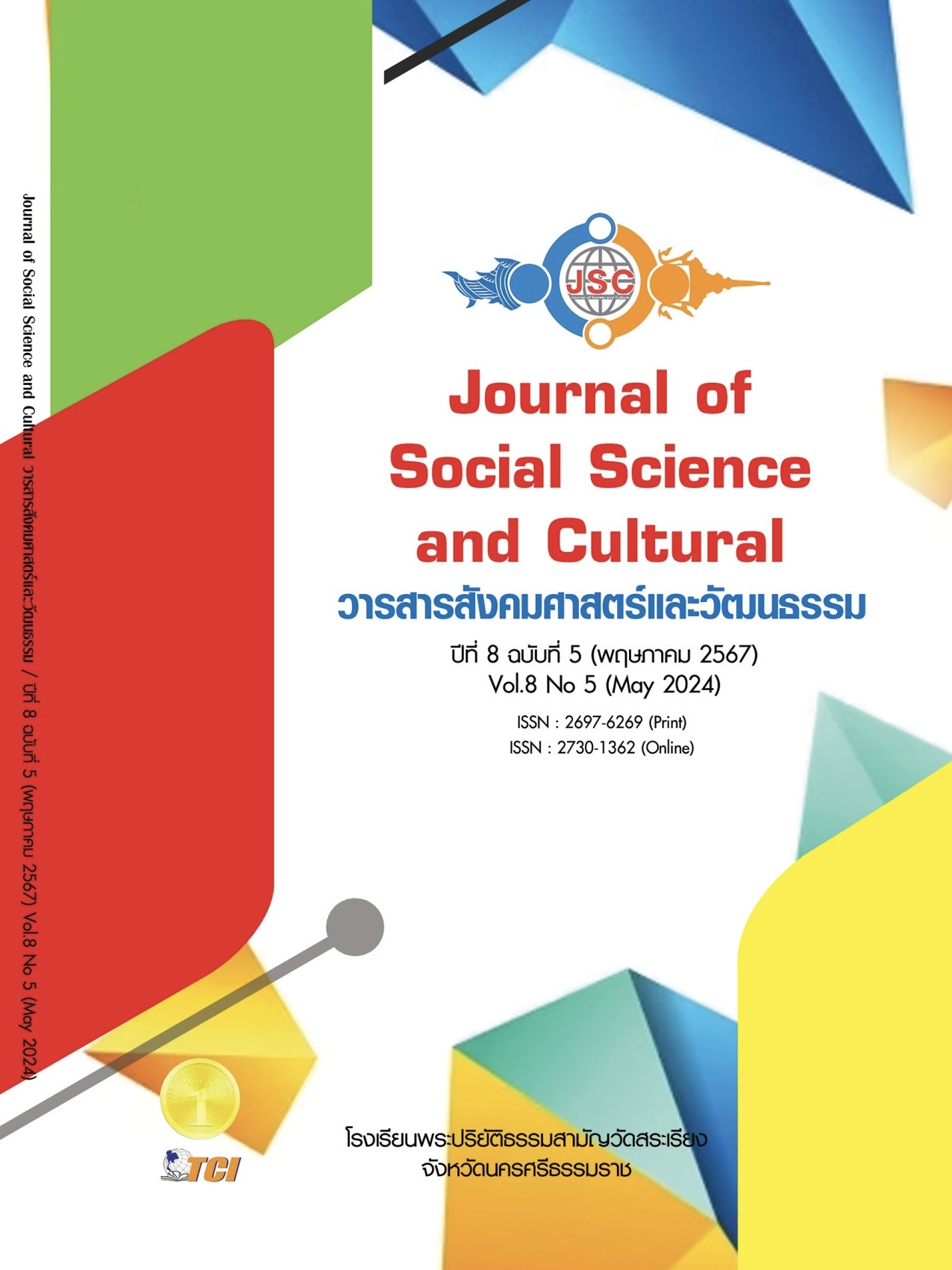PHRAYA: BELIEFS AND CONTEMPORARY AMULET DESIGN
Main Article Content
Abstract
Article Phraya: beliefs and contemporary amulet design It is part of the thesis. “Amulets: Thai’s Beliefs and Faiths Toward the New Creation of The Contemporary Culture Design” by applying knowledge from literature, questionnaires, and interviews to design. The objective is to study the beliefs and faith of Gen-Z people in order to design contemporary amulets. From collecting a questionnaire of 400 people, it was found that there are factors in choosing to rent and worship sacred amulets. That is, look at the symbol. representativeness and images of sacred things Amulets have an influence on life, which can be developed into fashion products and used as a tool for solving social, economic, and environmental problems. Including in-depth interviews with experts. Among academics related to folklore, beliefs, traditions, rituals, and business and producer groups Regarding amulets, a total of six people were brought in to analyze the knowledge gained for the design of contemporary amulets. Create works using the concept of a new economic trend, namely the creative economy. green economy and Sustainable Development Goals (SDGs). Conduct and test presentations with Gen-Z target groups, designed by modern artists. Bringing in the environmental dimension as affecting society to conduct the research, it was found that those interested were of a wider age range than the Gen-Z group. Most of them did not know Phra Dhanwantri. But there is satisfaction in the design of Phra Dhanwantri. I think it's very modern. Very suitable for carrying It has the greatest impact on donating medicine or money. Material from expired medicine is most closely linked to Thanwantri. It can help preserve the environment and solve most social and economic problems. and were most satisfied with the overall project, "WS:E1+."
Article Details
References
กรมสุขภาพจิต. (2563). New Normal ชีวิตวิถีใหม่. เรียกใช้เมื่อ 11 มกราคม 2567 จาก https://dmh.go.th/news/view.asp?id=2288.
เดอะโนวเลจ. (2566 ). BIO CIRCULAR GREEN ECONOMY. กรุงเทพมหานคร: สำนักงานบริหารและพัฒนาองค์ความรู้ (องค์การมหาชน).
ไทยพีบีเอส. (2563). “เวียนเทียนออนไลน์” วิถีใหม่ ทุกศาสนาฝ่าวิกฤตยุค COVID ระบาด. เรียกใช้เมื่อ 30 เมษายน 2567 จาก https://www.thaipbs.or.th/news/content/292115.
ประเสริฐ รุนรา. (2557). พิธีสวดนพเคราะห์: พลวัตของพิธีกรรมประดิษฐ์ในสังคมไทยปัจจุบัน. ใน วิทยานิพนธ์อักษรศาสตร์ดุษฎีบัณฑิต สาขาวิชาภาษาไทย. คณะอักษรศาสตร์ จุฬาลงกรณ์มหาวิทยาลัย.
ผ่องพันธุ์ มณีรัตน์. (2525). มานุษยวิทยากับการศึกษาคติชาวบ้าน. กรุงเทพมหานคร: มหาวิทยาลัยธรรมศาสตร์.
ผู้จัดการออนไลน์. (2563). “พาณิชย์” ทำโพลพบคนไทยยังนิยมทำบุญ ขอพรสิ่งศักดิ์สิทธิ์ แม้เศรษฐกิจซบ โควิด-19 ระบาด. เรียกใช้เมื่อ 11 มกราคม 2567 จาก https://mgronline.com/business/detail/9630000115605.
พุทโธ สุโขทัย. (2540). เครื่องรางของขลัง. กรุงเทพมหานคร: เจมินี่.
มณีรัตน์ กำลังเกื้อ. (2561). พิธีกรรมและประเพณีประดิษฐ์สารทเดือนสิบ ตำบลสิชล จังหวัดนครศรีธรรมราช. ใน วิทยานิพนธ์ศิลปศาสตรมหาบัณฑิต สาขาวิชาภาษาไทยและภาษาไทยประยุกต์. มหาวิทยาลัยสงขลานครินทร์.
วรลักษณ์ ผ่องสุขสวัสดิ์. (2565). คัมภีร์การรับประทานวิตามินและแร่ธาตุ เพื่อสุขภาพคนวัยทำงานนอนน้อยเครียด และติดหวาน (ตอนที่ 3). เรียกใช้เมื่อ 11 มกราคม 2567 จาก https://dmh.go.th/news/view.asp?id=2521.
ศิราพร ณ ถลาง. (2562). “คติชนสร้างสรรค์”: บทสังเคราะห์และทฤษฎี. (พิมพ์ครั้งที่2). กรุงเทพมหานคร: ศูนย์มานุษยวิทยาสิรินธร (องค์การมหาชน).
สยามรัฐออนไลน์. (2565). "วรวุฒิ" เสนอ "เครื่องราง - ของขลัง" เป็นซอฟท์พาวเวอร์ สร้างเศรษฐกิจไทย. เรียกใช้เมื่อ 11 มกราคม 2567 จาก https://siamrath.co.th/n/336839.
สำนักข่าวอิศรา. (2565). บทวิเคราะห์ - "โควิดโลกปี 2566" จะไปในทิศทางไหน วิกฤติสาธารณสุขจะหวนคืน?. เรียกใช้เมื่อ 11 มกราคม 2567 จาก https://www.isranews.org/article/isranews-scoop/114843-ccoviddddcccct.html.
สำนักงานส่งเสริมเศรษฐกิจสร้างสรรค์. (2561). เศรษฐกิจสร้างสรรค์ คืออะไร. เรียกใช้เมื่อ 11 มกราคม 2567 จาก https://www.cea.or.th/.
สุชาติ พรชัยวิเศษกุล. (2564). ผลกระทบการแพร่ระบาดโควิด-19 สถานการณ์ว่างงานและแนวทางรับมือ. เรียกใช้เมื่อ 11 มกราคม 2567 จาก https://www.doe.go.th/prd/assets/upload/files/satun_th/7ff740b9698a0551a0e4c5d7ff233621.pdf.
สุชาติ สุวรรณวงค์. (2557). ประเพณีแห่เทียนพรรษา: การอนุรักษ์และรูปแบบการจัดการด้านการประชาสัมพันธ์ เพื่อส่งเสริมการท่องเที่ยวเชิงวัฒนธรรมของภาครัฐ เอกชน และชุมชนจังหวัดอุบลราชธานี. ใน ดุษฎีนิพนธ์ปรัชญาดุษฎีบัณฑิต สาขาวิชาวัฒนธรรมศาสตร์. คณะวัฒนธรรมศาสตร์ มหาวิทยาลัยมหาสารคาม.
อภิชาติ จันทร์แดง. (2546). ความเชื่อ พิธีกรรม: กระบวนการเรียนรู้เพื่อศักยภาพการพึ่งตนเองของชุมชนชนบท: ศึกษาเฉพาะกรณีชุมชนบ้านยางหลวง ตำบลท่าผา อำเภอแม่แจ่ม จังหวัดเชียงใหม่. ใน วิทยานิพนธ์สังคมสงเคราะห์ศาสตร์มหาบัณฑิต ภาควิชาสังคมสงเคราะห์ศาสตร์. คณะสังคมสงเคราะห์
ศาสตร์ มหาวิทยาลัยธรรมศาสตร์.
อภิลักษณ์ เกษมผลกูล และสินีกานต์ แก้วกัณหา. (2563). รูปแบบและบทบาทความเชื่อในสถานการณ์ไวรัสโคโรนา: การศึกษาความเป็นพหุวัฒนธรรมในสังคมไทย. วารสารวิชาการมนุษย์ศาสตร์และสังคมศาสตร์ มหาวิทยาลัยบูรพา, 8(3), 260-286.
อำนาจ สุขพิพัฒน์. (2554). ประเพณีทอดข้าวสาร: การศึกษาแนวทางการอนุรักษ์และพัฒนากระบวนการจัดการประเพณีบุญทอดข้าวสาร โดยการมีส่วนร่วมของชุมชนอำเภอศรีสมเด็จจังหวัดร้อยเอ็ด. ใน วิทยานิพนธ์ศิลปศาสตรมหาบัณฑิต สาขาวิชาวัฒนธรรมศาสตร์. คณะวัฒนธรรมศาสตร์
มหาวิทยาลัยมหาสารคาม.
แอน เดือนเพ็ญ. (2565). พระสติ พระเครื่องจากพลาสติกที่เตือนให้ทุกคนบริโภคอย่างมีสติและรักสิ่งแวดล้อม. เรียกใช้เมื่อ 11 มกราคม 2567 จาก https://urbancreature.co/pra-sati-plastic/.


